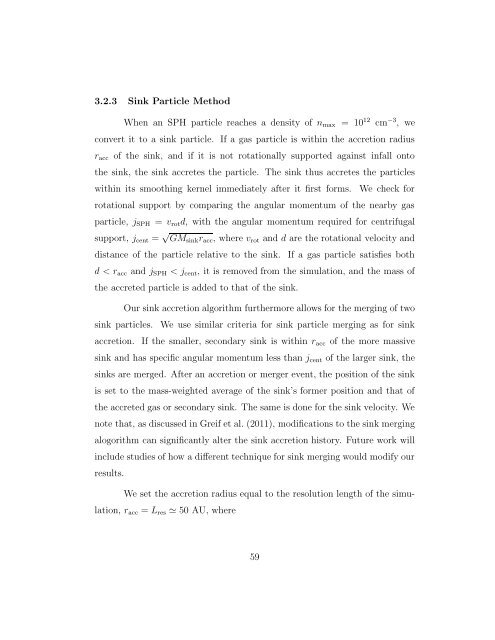Copyright by Athena Ranice Stacy 2011 - The University of Texas at ...
Copyright by Athena Ranice Stacy 2011 - The University of Texas at ...
Copyright by Athena Ranice Stacy 2011 - The University of Texas at ...
You also want an ePaper? Increase the reach of your titles
YUMPU automatically turns print PDFs into web optimized ePapers that Google loves.
3.2.3 Sink Particle Method<br />
When an SPH particle reaches a density <strong>of</strong> nmax = 10 12 cm −3 , we<br />
convert it to a sink particle. If a gas particle is within the accretion radius<br />
racc <strong>of</strong> the sink, and if it is not rot<strong>at</strong>ionally supported against infall onto<br />
the sink, the sink accretes the particle. <strong>The</strong> sink thus accretes the particles<br />
within its smoothing kernel immedi<strong>at</strong>ely after it first forms. We check for<br />
rot<strong>at</strong>ional support <strong>by</strong> comparing the angular momentum <strong>of</strong> the near<strong>by</strong> gas<br />
particle, jSPH = vrotd, with the angular momentum required for centrifugal<br />
support, jcent = √ GMsinkracc, where vrot and d are the rot<strong>at</strong>ional velocity and<br />
distance <strong>of</strong> the particle rel<strong>at</strong>ive to the sink. If a gas particle s<strong>at</strong>isfies both<br />
d < racc and jSPH < jcent, it is removed from the simul<strong>at</strong>ion, and the mass <strong>of</strong><br />
the accreted particle is added to th<strong>at</strong> <strong>of</strong> the sink.<br />
Our sink accretion algorithm furthermore allows for the merging <strong>of</strong> two<br />
sink particles. We use similar criteria for sink particle merging as for sink<br />
accretion. If the smaller, secondary sink is within racc <strong>of</strong> the more massive<br />
sink and has specific angular momentum less than jcent <strong>of</strong> the larger sink, the<br />
sinks are merged. After an accretion or merger event, the position <strong>of</strong> the sink<br />
is set to the mass-weighted average <strong>of</strong> the sink’s former position and th<strong>at</strong> <strong>of</strong><br />
the accreted gas or secondary sink. <strong>The</strong> same is done for the sink velocity. We<br />
note th<strong>at</strong>, as discussed in Greif et al. (<strong>2011</strong>), modific<strong>at</strong>ions to the sink merging<br />
alogorithm can significantly alter the sink accretion history. Future work will<br />
include studies <strong>of</strong> how a different technique for sink merging would modify our<br />
results.<br />
We set the accretion radius equal to the resolution length <strong>of</strong> the simu-<br />
l<strong>at</strong>ion, racc = Lres 50 AU, where<br />
59









